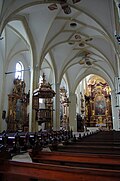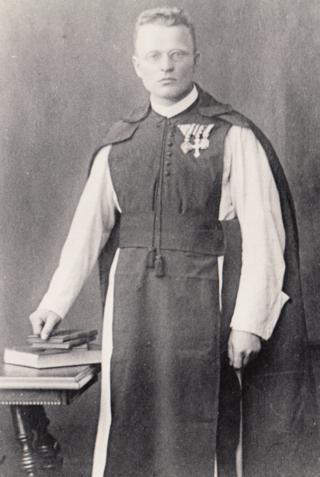

Neukloster Abbey was a Cistercian abbey in Wiener Neustadt, in Lower Austria. In 1881, it became a priory of Heiligenkreuz Abbey.


Neukloster Abbey was a Cistercian abbey in Wiener Neustadt, in Lower Austria. In 1881, it became a priory of Heiligenkreuz Abbey.
Contrary to the Cistercian custom of only building monasteries in remote areas, an exception was made for King Frederick. Frederick succeeded in freeing up the Dominican monastery next to his residence (founded by Leopold VI in 1227) for Cistercians from Rein Abbey. Because of the new beginning compared to the previous Dominican monastery and in allusion to the Cistercian original monastery of Cîteaux as the novum monasterium par excellence, Frederick's court monastery was called the "new" monastery. [1] The founding abbot was from Rein, but the second (from 1446) was Gottfried von Otterstätt, previously cellarer at Maulbronn Abbey.
In the decades following its foundation, the Neukloster monks were granted dispensations in order to work as pastors. Normally, laymen and women were not allowed to enter the Cistercians' convent churches, but a document from 1457 allows the presence of women at the rood screen during the celebration of mass in the Neukloster. [2]
Emperor Frederick was imaginative when it came to the abbey's endowment: the fortress of Rohr near Wildon was confiscated as a rebel estate and donated to Neukloster. The previous owner had probably died as a partisan of Albrecht VI. An annual payment of 300 pounds pfennigs from the parish of St. Peter in Ljubljana was also made to the new monastery.
In 1446, a large carved altar was erected in the abbey church, which is now the Wiener Neustädter Altar in St. Stephen's Cathedral in Vienna.
In 1467, Eleonor of Portugal, the wife of Emperor Frederick, was buried in the apse of the abbey church. Three children of the imperial couple are also buried there. But the burial place for which the entire Cistercian foundation project had been intended did not materialize: Emperor Frederick himself was buried in St. Stephen's Cathedral in Vienna in a magnificent tomb that had originally been placed (empty) in the chancel of the Neuklosterkirche. [3] There are several references to the imperial benefactor amidst the coats of arms along the nave's ceiling. The larger version of his famous AEIOU monogram appears twice. [4]
From 1797 to October 1803, the monastery served as a residence for the governor of Lombardy, Archduke Ferdinand Karl of Austria-Este, his wife Maria Beatrice d'Este and their children, after they had been exiled during the Coalition Wars. [5]
The Josephine reforms caused the monastery a great deal of trouble, but it was not abolished. In 1784, the church was rededicated as the second of Wiener Neustadt's parishes. In 1804, a monastery school was opened, which was transferred to state administration in 1871.
In 1793, Mozart's Requiem was performed in the collegiate church for the first time in its original purpose, during a Requiem Mass for Count Walsegg's deceased wife. [6]
The monastery suffered for centuries from insufficient funding; economic problems were the reason that in 1880/81 the Neukloster monastery was united with Heiligenkreuz Abbey, some 30 km away, as a unio extinctiva; as the convent died out, the property became a Heiligenkreuz priory.
In May 2017, a collection of around 4,700 art objects, known as the Kunst- und Wunderkammer (Cabinet of Art and Wonders), was opened. The monastery was an essential part of the Lower Austrian State Exhibition in 2019. A "room within a room" made of glass was built for viewing the library. The east façade towards the garden, the Chapel of the Holy Cross, and the baroque refectory with its frescoes by Johann Baptist Bergl were also restored and refurbished. [7]
For Empress Eleonore, see above. The New Monastery is the burial place of the West Hungarian noble family of the Counts of Mattersdorf-Forchtenstein from Aragon (Spain).

Heiligenkreuz Abbey is a Cistercian monastery in the village of Heiligenkreuz in the southern part of the Vienna woods, c. 13 km north-west of Baden in Lower Austria. It is the oldest continuously occupied Cistercian monastery in the world.

Eleanor of Portugal was Empress of the Holy Roman Empire. A Portuguese infanta (princess), daughter of King Edward of Portugal and his wife Eleanor of Aragon, she was the consort of Holy Roman Emperor Frederick III and the mother of Holy Roman Emperor Maximilian I.

Maulbronn Monastery is a former Cistercian abbey and ecclesiastical state in the Holy Roman Empire located at Maulbronn, Baden-Württemberg. The monastery complex, one of the best-preserved in Europe, was named a UNESCO World Heritage Site in 1993.

Zwettl Abbey is a Cistercian monastery located in Zwettl in Lower Austria, in the Diocese of St. Pölten.

Tegernsee Abbey is a former Benedictine monastery in the town and district of Tegernsee in Bavaria. Both the abbey and the town that grew up around it are named after the Tegernsee, the lake on the shores of which they are located. The name is from the Old High German tegarin seo, meaning great lake.

Wilhering Abbey is a Cistercian monastery in Wilhering in Upper Austria, about 8 km (5 mi) from Linz. Stift Wilhering is the oldest Cistercian monastery in Upper Austria. The buildings, re-constructed in the 18th century, are known for their spectacular Rococo decoration.

Viktring Abbey is a former Cistercian monastery in the Austrian state of Carinthia. Stift Viktring is now the name of the Roman Catholic parish in Viktring, since 1973 a district of the Carinthian capital Klagenfurt.

Heiligenkreuz is a municipality in the district of Baden, in the Austrian state of Lower Austria. It is known for the Cistercian monastery of Heiligenkreuz Abbey, the associated papal college Benedict XVI, commonly known as Hochschule Heiligenkreuz, and the Catholic Leopoldinum seminary.

Trumau is a town in the district of Baden in Lower Austria in Austria.

Ambrosius Petruzzy was an Italian master stonemason and baroque sculptor.

Rein Abbey is a Cistercian monastery in Rein near Gratwein, Styria, in Austria. Also known as the "Cradle of Styria", it is the oldest surviving Cistercian community in the world.

Schlierbach Abbey is a Cistercian monastery in Schlierbach, Austria founded in 1355, and rebuilt in the last quarter of the 17th century. The original foundation was a convent for nuns, abandoned around 1556 during the Protestant Reformation. The abbey was reoccupied as a monastery in 1620, and rebuilt in magnificent baroque style between 1672 and 1712. The monastery again went into decline with the upheavals before, during and after the Napoleonic era. It recovered only towards the end of the 19th century. In the 20th century the abbey established a viable economy based on a glass works, school, cheese manufacturing and other enterprises. The abbey is open to visitors, who may take tours, attend workshops and dine at the monastery restaurant.

Alberich Rabensteiner was a Cistercian monk who practiced at Heiligenkreuz Abbey. He was also prior and pastor at Neukloster Priory, Wiener Neustadt, Austria.
Christian Feurstein, was an Austrian Roman Catholic priest and Cistercian monk at Heiligenkreuz Abbey, Stiepel Priory, Rein Abbey in Gratwein-Straßengel, Styria. He served as abbot of the Rein Abbey from 2010 to 2015.

The Pope Benedict XVI Philosophical-Theological University, colloquially referred to as Hochschule Heiligenkreuz, is a private, Roman Catholic pontifical university located in Heiligenkreuz, Austria. Founded in 1802 by the Cistercian monks of Heiligenkreuz Abbey as a seminary, for much of the 19th century, the college remained very small, with less than 20 seminarians and several Cistercian instructors. During the late 19th century and 20th century, the college's profile grew, and more students arrived, made up of Cistercians, as well as diocesan and religious seminarians. In 1976 it earned university status, and Pope Benedict XVI named it a pontifical university upon his visit in 2007.

Anton Franz Wolfradt, O.Cist., O.S.B. was a Cistercian and Benedictine, Abbot of Wilhering then Kremsmünster, Prince-Bishop of Vienna, and President of the Hofkammer.

The composition of Mozart's unfinished Requiem, K. 626, his last work, is surrounded by the following events.

The Our Lady of Lourdes Grotto in Heiligenkreuz is a Lourdes grotto in Heiligenkreuz, a municipality in the Vienna Woods in the district of Baden near Vienna, which was created in 2017 by the Heiligenkreuz Abbey as a religious monument in honor of the Blessed Virgin Mary. Like all similar grottoes of Our Lady of Lourdes around the world, it is reminiscent of the world-famous grotto of the apparition of the Virgin Mary in the French pilgrimage town of Lourdes.